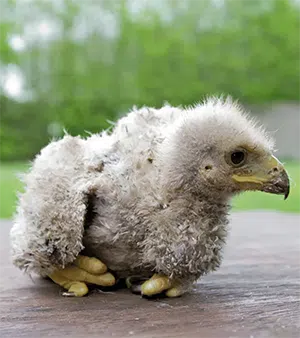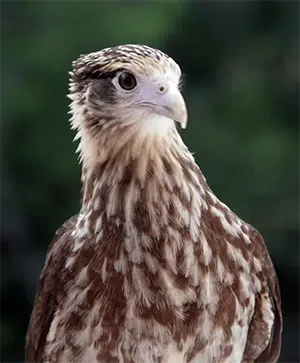Hawks are Brds of Prey and part of the Accipitridae family. This family is further divided into accipiters and buteos. Hawks are found on all continents, except Antarctica. Let's learn more about hawk species identification and baby hawk development:

Most Popular Species
 Red-Tailed Hawk
Red-Tailed Hawk
Probably the most common hawk in North America, the Red-Tailed-Hawk belongs to the buteo sub family; it sports broad, rounded wings and a short, wide (red) tail. Red-tailed Hawks can appear quite different, depending on their home region. In the Great Plains, you may find a pale hawk, with a light coloured head and more pink than red in the tail. Light-morph western hawks may have streaks on the underparts, and hawks in the southern United States are generally darker above and without a dark belly band. Here in Canada, we often see the all-dark 'Harlan' Red-Tailed Hawk.
Hunting
The Red-tailed Hawk hunts swoops down from an elevated perch to seize birds while flying, or pursuing prey on the ground. They do not engage in battle in the air.
Breeding
The Red-tailed Hawk reaches sexual maturity at two years of age. It is monogamous; it finds a mate for life but will take a new mate if its first mate dies. A pair of Red-Tailed Hawks will defend the same nesting territory for many years. In March or April, the female will lay 1-3 eggs and incubate them for 28-35 days.
Cooper's Hawk
The Cooper's Hawk is a medium-sized hawk with the classic accipiter shape: broad, rounded wings and a very long tail. Adults' plumage is steely blue-gray above with warm reddish bars on the underparts and thick dark bands on the tail. Juveniles display brown plumage above and crisply streaked with brown on the upper breast, You'll find the Cooper's Hawk anywhere from deep forests to leafy subdivisions and backyards.
Hunting
Cooper's Hawks fly with a flap-flap-glide pattern that is typical of accipiters. They often fly fast and low to the ground, then quickly rise up and over an obstruction, surprising their prey on the other side.
Breeding
Dad takes an active role in all things child rearring; he typically builds the nest and brings food while mum is busy incubating anywhere from 1 to 7 eggs. He takes over sitting on eggs to give mum a chance to eat and continues to provide food for her to feed to the nestlings.
Harris's Hawk
Harris's Hawks are fairly large and raptors with broad, rounded wings, long legs, and long tails. Females are considerable larger and can weigh almost twice as much as males. Harris's Hawks are striking dark brown birds with reddish brown feathers on the wings and thighs. Their tail is dark with a white rump and white terminal band. Young birds will have patches of white on the belly and wings.
Hunting
Harris's Hawks hunt and travel in groups, not unlike mammals, where some members of the group flush out prey and chase it towards the other hunters in the group. It is this willingness to cooperate which makes them such excellent partners in falconry.
Breeding
The breeding female does most of the incubation and caring for her nestlings. Other members of the group deliver food for her and her offspring. If enough food is availabale, she may have more than one brood per year.
 Diet and Feeding Habits of the Baby Hawk
Diet and Feeding Habits of the Baby Hawk
Hawk hatchlings require full-time care for the first 2 weeks of their lives. At about 16 days old, the chicks are starting to move about the nest and take an interest in the world below. By the third week, juvenile feathers come in on their wings and tails and they can begin feeding themselves. So, let's have a peek at what their diet actually looks like:
Small Mammals (Mice, Voles, Squirrels)
Since hawk nestlings cannot feed themselves for the first couple of weeks, feeding them is a collaborative effort. The male will do the hunting and deliver prey to mum near the nest. She will then rip the food into bite sized bits to feed to the wee ones. This delivered food will include small rodents, such as a viety of mice, rats, squirrels, chipmunks, moles, and voles. Larger animals such as rabbits or groundhogs are also on the menu, as are bats.
Birds
Of course, all birds of prey hunt smaller birds as well. From pigeons to gulls and starlings. Especially in captivity, quail are a a real staple.
Reptiles and Amphibians
Particularly when a young hawk's stealthy flight skills aren't quite yet fully developed and they just start out hunting, they may opt for a diet of earth worms, snakes, and frogs. Once a little more skilled, they will move on to lizards and other faster critters..
Insects
Grasshoppers and the likes may also make it onto the hawk menu, though this is likely more of and afernoon snack rather than a meal.
Aquatic Prey
This may not be as obvious as the previous dietary choices, but hawks also take to the waters! They have been seen to prey on anything from crayfish to small waterfowl.
 Hawk Conservation Efforts in Toronto
Hawk Conservation Efforts in Toronto
There are a number of organizations focusing on public education, including Hawkeye's own Falconry Experience. Master Falconer Dan Frankian and his staff are passionate about birds of prey and share their enthusiasm with the general public. Many an injured bird of prey have landed at Hawkeye Bird & Animal Control and completed their journey of recovery in the raptor rehabilitation program to be released back into the wild.
Habitat Protection
Raptors are among the most affected by extensive clearing or logging practices, and characteristically one of the first groups to disappear from disturbed areas . Forest dwelling hawks and other raptors have undergone serious declines during the last century when large native forests of Ontario have seen clearing or disturbance. Protecting especially our deciduous forests and populations within is critical to the continued survival of birds of prey.
Monitoring and Research
Birds of prey are a critical element of a functioning ecosystem. Raptors are in need of protection and conservation as much as any other group of creatures. Observation is important, as their thriving or decline can be one of the first indicators of an imbalance in the ecosystem and an opportunity to intervene.
Reducing Human-Hawk Conflicts
Under no circumstances should you approach a hawk's nest. Hawks are fierce protectors of their offspring and will attack. This is known and predictable hawk nesting behavior. If you discover a nest where it should not be (warehouse, construction site, communications tower, etc.) and will interfere with human or business activities, you must call a Bird Control Specialist, experienced in dealing with hawks.
Window Collision Prevention
Windows reflecting foliage or sky look like an invite to birds of all sizes. Collisions are frequent and often fatal for birds of prey. To avoid collisions with large picture windows consider installing products like screens, films, or netting. Cornell Lab has a variety of ideas and suggestions to make your window less likely to be the scene of a fatal accident.
Learn About Hawk Fledglings and Adults Through Hawkeye's Birds of Prey Program!
We invite you to visit our Falconry Experience just outside Toronto to learn about Birds of Prey, ask questions, observe and even fly a Harris's Hawk yourself. You will come away with a whole new appreciation and love for these majestic birds. Contact Hawkeye Bird & Animal Control or book your Falconry Experience online!














